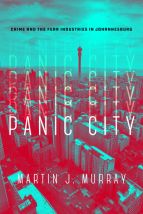Panic City: Crime and the Fear Industries in Johannesburg

Panic City lays out its thesis statement early and explicitly: “The central argument of this book is that heightened anxieties about the perils of everyday urban living have spilled over into an obsession with security, in which an oversaturation of ominous signs of vulnerability has produced what amounts to a constant state of collective panic that more often than not identifies the black urban poor as the source of danger.” (pages xi–xii)
This “constant state of collective panic” in Johannesburg reflects a wide distrust in public policing, and a concomitant rise of lucrative and varied private security companies. But Murray argues that there is a fuzzy border between the two. For one thing, there is something of a revolving door, as police officers and soldiers often leave the force for better-paid positions in the private sector. The latter has become an important source of employment in post-apartheid South Africa, employing more people and accounting for more spending than public policing. At the same time, private citizens occasionally take up the responsibility of state provision, for instance when suburban homeowners pay the salaries of individual police officers. And there is some degree of information sharing between the two.
Both sectors have cultivated a reputation for brutality, but private companies depend for continued business on so-called preemptive crime deterrence and the exaggeration of threats. According to Murray, “proactive public-space policing has less to do with personal safety and the threat of crime and more to do with expurgating unsightly persons and their transgressive antisocial behaviors and, in so doing, improving the aesthetic appeal of public spaces” (page 165).
But one strategy of the rich has been to redefine what public space even is. Murray describes wealthy neighbourhoods that have transformed into fortresses, to the extent that sidewalks have disappeared and sentry boxes and surveillance cameras are ubiquitous. In extreme cases, suburban communities with political influence (or in defiance of the laws) have used gates and road closures to seal themselves off entirely to through traffic – in effect creating borders within the city.
In Murray’s analysis, affluent Johannesburg residents “have used their fears about the dangerous city to justify their withdrawal into exclusive, fortified enclaves for residence, work, leisure, and consumption. The steady accretion of such sequestered places as citadel office complexes, gated residential communities, enclosed shopping malls, festival marketplaces, barricaded surburban neighborhoods, and other gentrified ‘shoppertainment’ fantasy-scapes have set in motion new patterns of spatial segregation and social exclusion that have substituted socioeoconomic status for the formal racial separation that prevailed under apartheid rule.” (page xx)
Such details paint a picture of a Johannesburg that is several cities in one. “The urban poor have filled in the voids, those leftover spaces in the cityscape, abandoned by the anxious middle-class residents who have retreated behind walls, barriers, and fortifications. As a general rule, middle-class residents have dispensed with the utopian ideal of sharing and using the public spaces of the city in equal measure. Only those who do not have a choice are left to fashion their everyday lives in these derelict and dangerous areas.” (page 13) The race toward ever more restrictive and expensive security infrastructure also harms those without the resources to compete, as opportunistic crime gets displaced into less affluent neighbourhoods.
The cleaving of the city into heavily securitized zones also perpetuates inequality. If fear of crime is one side of the coin, fear of depressed property values is the other. And in the book’s analysis, “the accruing socioeconomic privilege of white middle-class suburban homeowners depends on and is reinforced by the projection of chaos and criminality onto a black underclass” (page 103).
The book does not reach any resolutions. Murray notes that in his time in Johannesburg, he has been robbed and stabbed, and the city’s crime rate remains stubbornly high. From this perspective, it may be understandable that the well-heeled seek to insulate themselves from disorder. But Panic City’s account of the ballooning of high-tech, high-cost services suggests that the exclusionary, racist and often illegal tools advanced by the private security industry are not working – that disengagement with the government, and with the rest of the city, is ultimately failing to produce a safer Johannesburg.
Introduction available at:
https://www.sup.org/books/extra/?id=30559&i=Introduction.html
Further reading:
Beall, Jo, Owen Crankshaw and Susan Parnell (2000), “Local government, poverty reduction and inequality in Johannesburg”, Environment and Urbanization Vol 12, No 1, pages 107–122, available at https://journals.sagepub.com/doi/pdf/10.1177/095624780001200108.
Moser, Caroline O N and Cathy McIlwaine (2014), “Editorial: New frontiers in twenty-first century urban conflict and violence”, Environment and Urbanization Vol 26, No 2, pages 331–344, available at https://journals.sagepub.com/doi/full/10.1177/0956247814546283.
Oluseyi, O Fabiyi (2006), “Analysis of inter-connectivity levels of urban street networks and social interactions in enclosed neighbourhoods in Johannesburg RSA”, Humanity & Social Sciences Journal Vol 1, No 1, pages 79–95, available at http://citeseerx.ist.psu.edu/viewdoc/summary?doi=10.1.1.509.1372.
Search the Book notes database
Our Book notes database contains details and summaries of all the publications included in Book notes since 1993 - with details on how to obtain/download.
Use the search form above, or visit the Book notes landing page for more options and latest content.
For a searchable database for papers in Environment and Urbanization, go to http://eau.sagepub.com/

